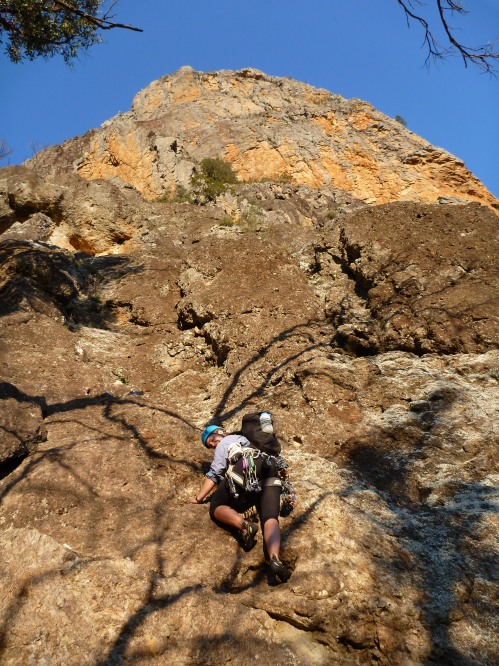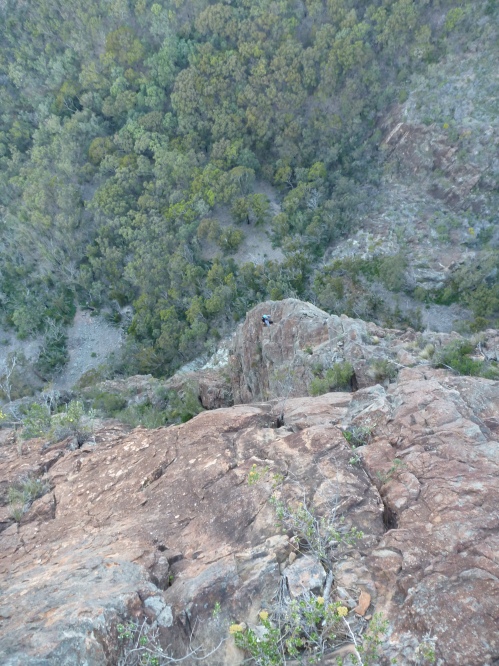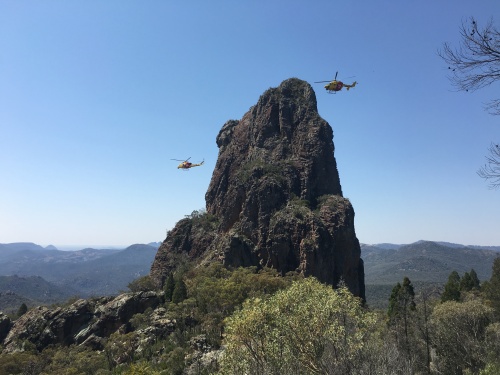In the gathering dark on the 6th of October this year, my climbing partner and I scrambled onto the summit of Belougery Spire. On our last visit to the summit of Belougery, by a different route, about 10 years previously, we had used two ropes, which meant we only needed to make one abseil on the descent. This time we only took one rope, as we knew that an additional abseil anchor point had been added to the descent route, meaning we could descend the vertical part of the descent in 2 shorter abseils. We had set off from camp before sunrise to climb a climb called ‘Out and Beyond’. At over 300 metres high, it is one of Australia’s longest rock climbs. After signing the visitors book and taking in the amazing view of the Warrumbungles National Park and surrounding countryside from the summit, we switched on our head torches and located the fixed abseil chains that marked the top of the descent route.

I abseiled first and the picture I took at the bottom of the first abseil shows us all smiles as my partner arrived, ready to pull our rope down, find its middle-marker, thread it through the abseil chain and throw the two even ends over the edge in preparation for doing the final abseil. After that we could scramble our way down and back to the ridge where we had earlier left a water bottle, en-route to our camp and a hot meal, a comfy bed and a well-earned sleep. I have been climbing, caving and canyoning for over 40 years. I have done probably well over 1000 abseils and never had a serious incident. It was late, we were tired and quite thirsty, I was a bit euphoric, and we had done this abseiling thing sooo many times before. We had fallen into the trap that catches out so many mountaineers after they achieve their primary objective and then set auto-pilot for the comparatively easy exercise of descending down the mountain, dreaming along the way of the food, warmth, comfort and safety that awaits them at camp. Unknown to us, complacency had crept into our decision making. Lack of attention to detail. Disregard, or lack of regard for stock standard routines that cause minimal inconvenience, but ensure safety. Like tying knots in both ends of the rope before tossing them over the edge. Like locating both ends of the rope and then coiling it from those ends, ensuring that the last coil picks up the mid-point of the rope. Like tying a Stein knot (or similar) in the ropes at the top, so that each end is secured independently for the first abseiler and only one end needs to reach the ground to ensure safety. Like double checking each other’s actions. Like all the things that hindsight screams at me every time I go back over what went wrong, any one of which would have averted a very near fatal fall.

The reality was that the rope lengths weren’t equal. We had failed to accurately locate the dark smudges that mark the middle of the rope and hadn’t tied knots in the ends, which would have jammed in my abseil device and prevented my fall. I hadn’t ever needed knots in my previous 1000 abseils, so had foolishly discounted the possibility of making my first mistake on this particular night. As a consequence, I didn’t keep an eagle-eye on whether I had 2 lengths of rope below me coming into my abseil device so when I got 10 or 15 metres down the cliff, without any warning, I found myself free-falling backwards into the night. My partner suddenly saw and heard the loose end of the rope screaming through the ring of the abseil chain and made a futile but courageous effort to grab it and stop me falling. She received rope burns to her hands for her efforts. In a flash, myself, the rope, and the light-hearted, relatively care-free atmosphere of our big day out disappeared into the darkness. In her words: “I assumed it was a fatal fall as there was no response from him, just a gurgling laboured breathing. This stopped after five min. After another 10 min the sound of rustling came from below, followed by moaning.” I slowly regained my senses and the enormous weight of a dead climbing companion and good friend had been lifted off my partner’s shoulders. After an hour we engaged in a typical concussion conversation where the same questions are repeated endlessly (or at least 20 times in my case). My conversation went along the lines of the following: “Where am I?, What happened? Who are you? I thought we were kayaking!? (my partner tells me I actually said this) Is the car at the top or the bottom? After a while, I regained my senses and diagnosed that I had probably broken 4-6 ribs, but apart from that, I wasn’t tooo bad. Some time during the night I decided that it was up to me to get back to camp and raise the alarm, as my partner was now stuck on top of the spire, with no rope, no water and (I thought) no way down. My recollection is that I collected the rope, (carefully checking that I had the half-way mark this time), set up an abseil and abseiled further down the cliff. After getting the pain and my breathing under control, I did this again, until I could see from the silhouette of the ridgeline in the dark above me and decided that I shouldn’t go any lower. (My memory is that I went a considerable distance and that it took hours, but apparently I only moved about 15 metres! That is an indication of how badly smashed up I was, both physically and mentally) So I laid out the rope underneath me to provide insulation and comfort and lay down to rest until first light, when I would be able to see where the actual descent track went. I had resolved that I would crawl a few kilometres on my hands and knees if necessary, to raise the alarm. Every couple hours throughout the night my partner would yell down to me and I would yell back. Her last yell just after first light woke me up, so I’d obviously been able to get to sleep for a while at least. She then devised a brilliant and rather daring method of clipping together all the small pieces of climbing protection and slings which she had collected as she climbed the last pitch the previous day into a long daisy chain. She had, in her own words: “enough gear to link it all together, anchoring it from the abseil ring to create a ‘daisy chain’ that would get me to a small tree growing from a crack below. I made it to the tree, secured the Daisy chain of gear. Then went back up to the abseil point above to release the top of the chain. By doing this it would now become the bottom of a chain secured to the tree. Monkeying down the makeshift Daisy chain got me to the bottom of the abseil. I got to my mate and we decided to try and move him to the prominent pinnacle at Belougery, allowing easier emergency access and a cool gully for him to rest in in the meantime. It took an hour or more to get there through scrambling and setting up guiding ropes for him but we made it. Stashed water from the previous day was a saviour! I raced over to the hut and raised the alarm. Within 3 hours he was being choppered out. Parks, emergency chopper crew and volunteers were fantastic!”
Some time during the night I decided that it was up to me to get back to camp and raise the alarm, as my partner was now stuck on top of the spire, with no rope, no water and (I thought) no way down. My recollection is that I collected the rope, (carefully checking that I had the half-way mark this time), set up an abseil and abseiled further down the cliff. After getting the pain and my breathing under control, I did this again, until I could see from the silhouette of the ridgeline in the dark above me and decided that I shouldn’t go any lower. (My memory is that I went a considerable distance and that it took hours, but apparently I only moved about 15 metres! That is an indication of how badly smashed up I was, both physically and mentally) So I laid out the rope underneath me to provide insulation and comfort and lay down to rest until first light, when I would be able to see where the actual descent track went. I had resolved that I would crawl a few kilometres on my hands and knees if necessary, to raise the alarm. Every couple hours throughout the night my partner would yell down to me and I would yell back. Her last yell just after first light woke me up, so I’d obviously been able to get to sleep for a while at least. She then devised a brilliant and rather daring method of clipping together all the small pieces of climbing protection and slings which she had collected as she climbed the last pitch the previous day into a long daisy chain. She had, in her own words: “enough gear to link it all together, anchoring it from the abseil ring to create a ‘daisy chain’ that would get me to a small tree growing from a crack below. I made it to the tree, secured the Daisy chain of gear. Then went back up to the abseil point above to release the top of the chain. By doing this it would now become the bottom of a chain secured to the tree. Monkeying down the makeshift Daisy chain got me to the bottom of the abseil. I got to my mate and we decided to try and move him to the prominent pinnacle at Belougery, allowing easier emergency access and a cool gully for him to rest in in the meantime. It took an hour or more to get there through scrambling and setting up guiding ropes for him but we made it. Stashed water from the previous day was a saviour! I raced over to the hut and raised the alarm. Within 3 hours he was being choppered out. Parks, emergency chopper crew and volunteers were fantastic!” The various pains I could feel in different parts of my body had now convinced me that I was too badly smashed up to walk out by myself. I now know that I basically shattered my T4 vertebrae and accompanying ligaments so I might have rendered myself a paraplegic if I had tried to walk out and fallen again in a way that impacted on that part of my spine.
The various pains I could feel in different parts of my body had now convinced me that I was too badly smashed up to walk out by myself. I now know that I basically shattered my T4 vertebrae and accompanying ligaments so I might have rendered myself a paraplegic if I had tried to walk out and fallen again in a way that impacted on that part of my spine.

Maggots keeping Andrew’s ear clean.
I was hopeful that I had just broken a few ribs but in reality I had broken three ribs, my sternum and coccyx, three fractured vertebrae and my helmet had chopped a bit off my ear. My helmet now has a big split in it, so presumably I can thank it for saving my life, before cursing it for chopping off part of my ear. Despite my best efforts, the local flies found my injured ear to be irresistible and the medical staff at John Hunter Hospital convinced me that their children (which were up and wriggling (and nibbling) within 24 hours) were doing more good than harm. So I put up with the maggots until the operation to sew my ear back together in a couple days’ time.
The first people to arrive on the scene (at around 11:15am) were local rangers who had hotfooted it up the track. It was great to see them. At around 12:30 the first rescue helicopter (from Tamworth) appeared overhead, but apparently cost issues had inspired the State Government to take away its winch facilities in 2013, so it had no chance of getting me out of there. It did, however manage to drop off a couple of very welcome paramedics, who looked after and stayed with me until the Newcastle based chopper (which thankfully still has its winch operational) was able to reach me (around 1:44pm). I’ve done numerous remote area first aid courses myself and helped in a few wilderness rescues, and I was very impressed by the competence and professionalism of all the crew who helped in my rescue. They’re a credit to their respective services and largely unsung Australian heroes IMHO. I’m humbled and immensely grateful for their selflessness and generosity of spirit. I’ve since become aware of the huge number of people who turned out to help me. Most of whom I never met. I don’t have the resources to thank them financially and odds are, I won’t meet most of them again in order to personally thank them. I’m thinking that my thanks is going to express itself by becoming more involved with my local rescue organisations and to bring myself up to more advanced level first aid qualifications. This will make me more useful and able to help others, including usually fiercely self-reliant people who, like me, never really imagined that one day they would suddenly be in need of the assistance of strangers, as they lay broken and in pain or in a pool of their own blood. At the foot of a cliff or some other lonely bush setting, trying to avoid the attentions of the flies and ants who are only too willing to keep them company. Strangers whose selfless compassion should give us all heart and reason to take pride in being Australian. Not in some vacuous jingoistic way, but proud of the fact that so many people in our society demonstrate in the most practical and selfless ways, that empathy, compassion and a sense of community solidarity is alive and well. This is evidenced not only in the actions of the volunteers and professionals involved, but also in the generosity of those who contribute financially to the rescue and emergency services. Services that they are statistically unlikely to ever benefit from in a personal sense, as victims in need of the expertise and generosity of strangers.
To fellow climbers, my advice is: NEVER, EVER, let familiarity with climbing and abseiling procedures breed complacency and lack of attention to detail. Everything can go horribly wrong in a split second and even if the victim isn’t you, it would be horrible to have to live with the knowledge that your flippant or ‘chillaxed, untroubled coolness’ caused the death or permanent disability of your climbing partner. Even though you have to trust your partners to a large extent, where possible double check what they’re doing, being especially vigilant over the things that will result in catastrophic failure if they’re done wrong. I’ve since spoken to very experienced climbers who don’t always tie knots in the ends of their abseil ropes. But they have other procedures to ensure that they have identified the midpoints of their rope. After this accident, I’m pretty sure I will be tying either stein knots or knots in the end of the rope from now on. It would also be a good idea to practice prussiking on two strands of rope, which is what you’ll probably have to do if you ever do find your abseil device clogged up with a knot while you’re dangling in mid-air. It’s not easy, but very doable, and with all these things, it’s a lot easier if you’ve practiced it in the gym (with a back-up safety rope) before having to do it in the dark, on your own (out of sight, or hearing from your companions) while you’re tired and emotional after a big day out.
Article and photos by Andrew Collins





























